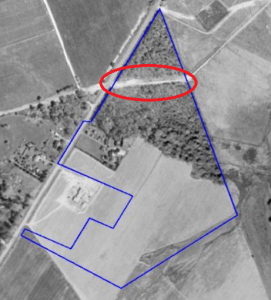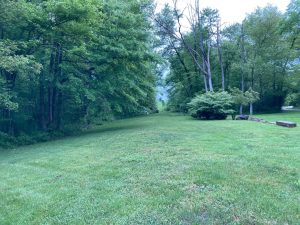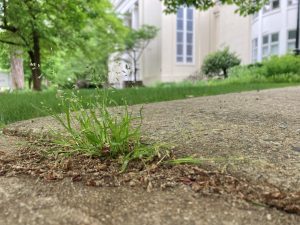Matthew 13:1-23
May 26
Nathan T. Stucky
Jump to audio
“Listen! A sower went out to sow…”
I wonder. What do you know about God? What do you know about God’s kingdom? About the Gospel? About God’s work in the world?
I wonder if you’ll humor me for a second. Take just a moment and think of one thing you really believe about God – something for which you might say, “I know this to be true about God.”
Perhaps it is that God is love. Or God is kind. Perhaps you know deep in your being that God is with you. Or that God is abundantly gracious.
Go ahead. Take just a second. What do you know about God?
Now I wonder – if you’re willing to humor me just a bit more – I wonder if you can connect that knowledge about God with a particular location, a place. What I wonder is this: Where did you learn that about God?
If, for example, you believe down in the depths of your soul that God is love? Where did you learn that? Who taught you?
If you know to the core of your being that God is present, who were your teachers?
What do you know about God?
Where did you learn that?
Who taught you?
In the fall of 2007, I was ready to learn more about God. In our years since college and getting married, Janel and I had spent six years on the eastern shore of Maryland where I served as a youth pastor. We then returned to Kansas where I farmed for about two years. Those two years had become a season of intense vocational discernment.
In 2007, I gave up the fight. I finally owned up to the fact that I was called to ministry. We would leave the farm and move to Princeton so I could learn more about God as a student at Princeton Theological Seminary. I would learn more about God from faculty in theology, bible, history, and practical theology. I would learn from fellow classmates, from field education and coursework. I would learn in the library and Stuart Hall, and yes, in the seminary chapel. The quest, after all, was not merely to know about God, but to know God.
I came to Princeton because I wanted to know God, and I wanted to know how I might best serve God in the world.
Where do we go to learn more of God? Who will teach us? What might we learn?
What do you know of God? Who taught you? Where did you go to learn it?
“Listen! A sower went out to sow…”
Some years ago, a colleague sent me an article about the Parable of the Sower by an ecological geologist from Johns Hopkins University. The article sought an ecological interpretation of the Parable. It argued that “[r]eflecting on the dynamics of Galilean ecology can deepen our understanding of [the] parable.”[1]
The article’s author, George W. Fisher, recognized the dominant lines of interpretation for the Parable. They are the interpretations that I grew up with. Perhaps you’ve heard them, as well. They read in the Parable not a single story, but four stories within a single parable, and those four stories convey three failures and one success.
Seed on good soil equals success. Seed on path, rocky ground, or thorny ground equals failure. The moral of the story is simple. Be good soil. But what does that even mean? Can soil simply choose to be good? How does one become good soil?
Where do we go to learn more of God and Gospel?
As I already mentioned, Fisher thought Galilean ecology might be able to teach us something.
Over and against the typical three failures and one success interpretations, an ecological perspective attuned to the particularities of the Galilean countryside recognizes a deeper thread of connection between all four settings. According to Fisher, Galilean ecology challenges the reader to embrace the parable as a single Gospel story rather than four smaller tales. On this reading, each landing place of the sower’s seed leads logically to the next. The story tells us not only about the growth of grain, but also and perhaps more significantly about the growth of soil. Each landing place for the seed moves the reader through the earth’s natural processes of growing soil.
The first seeds in the parable land on a path where “birds came and ate them up.” Here we might ask, “Why is this a failure?” The seed provides nourishment for the birds. Additionally, birds provide a primary outlet through which seed moves. The seed moves through the birds’ digestive tract (In fact, some seeds will not germinate unless they pass through the digestive tract of an animal!) and then the seed is deposited pre-fertilized in another location, perhaps on rocky ground. There it can germinate, even amid thin soil. Yes, the thin soil limits the lifespan of the plant, but when the plant dies, its organic matter decays back into the ground. The addition of this tiny gift of organic matter renders the soil just a little less thin. Over generations of this life and death process, soil gradually grows. In time, the soil can sustain larger plant life, perhaps thornbushes.
Those thornbushes help hold the soil in place, attract greater populations of birds and other wildlife, and thus attract even greater additions of organic matter to the slowly growing soil. In time, the cycles of life, death, and new life build soil that is capable of a remarkable harvest, maybe even a hundredfold.
Or at least this is what George W. Fisher was arguing in his article.
Now to be clear, I appreciated Fisher’s article from the beginning. It demonstrated the kind of interdisciplinary theological exploration that can animate the life of Christian faith. The preacher in me recognized a powerful sermon illustration or two.
But I also had questions, some of which undoubtedly emerged from a lifetime of hearing the parable as a tale of three losers and one winner. I wanted to believe it…but I just wasn’t sure.
“Listen! A sower went out to sow…”
Where do we go to learn more of God and Gospel? Who will teach us?
If you pull into the Farminary driveway, stop when you are about twenty feet from the road, and look ahead and to the left, you see a perfectly straight clearing about forty feet wide that runs through the woods. That clearing’s longer story forever links it in my mind to the Parable of the Sower.
The path was originally cut in the 1950s so that a natural gas pipeline could be installed.
Because gas pipelines are inspected aerially, the wide path over the gas line needed to be maintained. To facilitate this maintenance and access for the heavy equipment that would do the maintenance, the utility company dug out six to eight inches of topsoil and then backfilled with gravel. The result? A forty-foot wide gravel road, up to eight inches deep, utterly devoid of plant life, and intended for heavy machinery.

You can see this gravel path circled in red from this 1957 aerial photograph of the land that is now the Farminary – a stark white path cutting through the woods.
And yet…even amid all the hubbub of the laying of the gas line and the construction of that path, and the laying of the stone, the local birds carried on with their lives.
No doubt, little time passed between the completion of the rocky path and the first seed deposit by an avian friend. Perhaps the wind blew the thinnest layer of dust atop the gravel. Eventually, it happened. One of those seeds took root. And with that, the ecological parade of resistance to the machinations of the world had begun. Yes, the first plants likely only survived a few days, but with each passing, the forces of life atop the gravel path grew.
Seventy years of life, death, and new life have transformed the gravel access road. If you go look now, this is what you’ll see – a verdant path.

When you walk the path now, you have no sense that you are walking on a gravel foundation. You feel only the softness of grass and soil beneath your feet. By the time the Farminary began in 2015, the gravel was completely undetectable.
I never would have known about the gravel road had our neighbor not mentioned it to me one day at the farm.
Eventually, the possible connection between the path and the parable dawned on me. When it did, I headed straight for the barn and grabbed a shovel. The shovel provided an easy way to test the stories. Did the path really use to be a gravel road? Could the parable really be a story of both the growth of seeds and the growth of soil through endless seasons of life and death?
I carried the shovel straight to the path, took the handle in both hands, raised my hands above my head, and then drove the tip of the shovel into the ground. Clink! The unmistakable sound of steel shovel against gravel rang through the air.
That moment – and the previous seventy years of life and death on the path – forever changed my reading of the Parable of the Sower. I can no longer read it as a story of three failures and one success. I can only see it as one long story that encompasses countless generations, endless cycles of life, death, and new life that in time can bring about a rich harvest even from the places and spaces that today seem most lifeless.
But what about Jesus’s explanation of the parable?
What about the evil one who snatches away what is sown, or the trouble and persecution that arises on account of the word, or the cares of the world and the lure of wealth that choke the word?
Well, friends, I think the witness and testimony of the stone path turned verdant walkway at the farm stands. Life still gets the last word.
The evil one cannot stop it.
Trouble and persecution cannot stop it.
The cares of the world cannot stop it.
Not even the allure of wealth can stop it.
Yes, it will require countless generations of life, death, and new life, but Life persists. The Gospel of Jesus Christ is the Gospel of Life. It is the Gospel of Life through Death, and the gates of hell will not prevail against it.
Thanks be to God, we have the privilege of hearing that message week in and week out here in this sanctuary. But friends, there are more witnesses to this Gospel.
Where will we go to perceive it?!
The hills rejoice. The rocks cry out. The trees clap their hands. Mountains and hills burst forth into song. Creation groans.
Are we willing to listen? Are we willing to go there?
Friends, you have my permission to go to the Farminary any day. Take a shovel with you or borrow one from the barn. Go to the path. Try to drive the shovel into it. And pay attention. Open yourself to the witness of the rocks and the birds, the stones, the thorns, and the soil. They just might bear witness to the Gospel of life, to the possibility that the parable tells one long story of life, not four stories that neatly fit into our categories of success and failure.
But you don’t have to go that far. You don’t have to drive the three miles from here to the farm. Just step outside! Look down!

Do you see it?
Do you see the life growing straight out of the path, out of the sidewalk?
Do you hear the witness to the fate of every lifeless path?
Plants and vegetation sprouting in the cracks proclaiming the power of life, even in the face of our most diligent efforts to cover it up, pave it over, or trample it down.
What do you know about God?
Where did you learn that?
Who taught you?
Are you willing to learn from seeds, birds, rocks, and thornbushes? Are you willing to learn from soil, waters and trees? They bear the weight of human sin, but they also proclaim a longer story.
In the end, life gets the last word.
[1] Fisher, 378.
